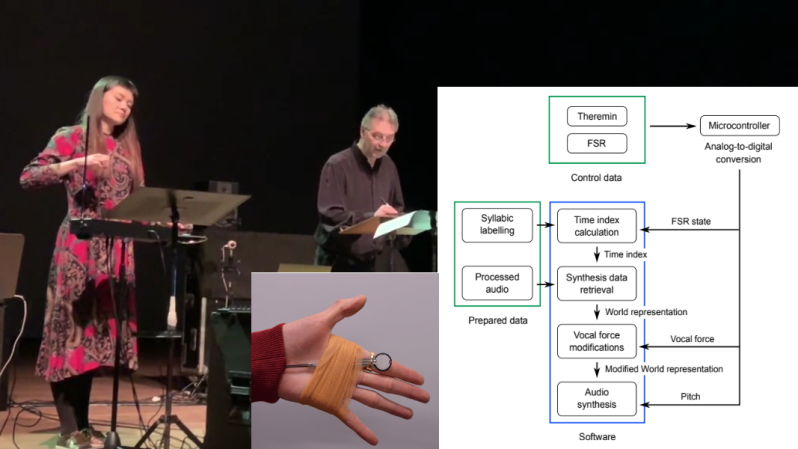Every once in a while, we come across a project that adds a ridiculously good twist on an existing design. This is exactly what [Xiao Xiao] and the team at LAM research group at the Institut d’Alembert in Paris have done. Their project T-VOKS is a singing and Speaking Theremin that is sure to drive everyone in the office crazy. (YouTube link, embedded below for your viewing pleasure.)
For the uninitiated, the Theremin is an electronic music instrument that does not require physical contact. Instead, it uses two antennas to sense the distance of the operators hands and uses that to modulate the pitch and volume of the output audio. From music concerts to movie background music to even scaring the neighbours, this instrument can do it all.
T-VOKS is a different take on the instrument, and it interfaces with a voice synthesizer to sing. There is an additional sensor that is used for the syllable sequencing, and the video below shows the gadget in operation. The icing on the cake is the instrument playing, or should that be singing in an actual concert. There is also a research paper detailing the operation on Dropbox[PDF] if you need the nitty-gritty.
We wonder how a TTS engine would work with this idea and hope to see some more projects like it in the future. Fore those looking to get started, have a look at the build guide for a DIY theremin.















All theremins are speaking theremins to gamers who play Oxygen Not Included
Soo, it’s like a theremin controlled autotune..? It sounds wierd to me…
Congrats for the performance, but not sure the world really needs another autotune ! Never forget this : https://www.youtube.com/watch?v=nZXRV4MezEw&t=105
No no no no no!
https://youtu.be/wW350_zku00
creepy, i hope it gets better, but hey, i’ve heard guitars get articulate.
It already sings better than me, come to think of it, the cat sings better than me.
Meh. Bell Labs did it…
https://www.youtube.com/watch?v=5hyI_dM5cGo
Urs Gaudenz made a pick and place machine to produce an Arduino shield that is OpenTheremin. I believe he has kits left though I can’t post a link here somehow.
https://hackaday.com/2016/01/24/finally-a-modern-theremin/
The Voder, yes. I have brainstormed on making 5 or more variable sensors on a hand sized bar that I could play my self-sustaining guitar with. Then it would be truly singing with my hand. I have my Apollo era memory seeing those demos on TV back then from that “futurerama” worlds fair of ’39.
The article mentions voice synthesis but this seems to be voice capture and cued playback with pitch added by hand. I have wondered what it would be like on the first gen digital cellphones if the hum-tone were fixed and the skimpy 2 octave treble range allowed to pass. Your conversation to another would sound like a monotone robot from a ’50’s sci-fi. Back in the ’90’s I heard on 46/49MMz phones a neighbor that used an electronic larynx. At the time voice synthesis sounded similar. Monotone and a rise in pitch at the end.
The Voder went on to become what those crappy candy-bar era phones used. Thanks for progress, now it’s better.. That model worked poorly with middle eastern languages and hampered our intelligence during the Iraq war.